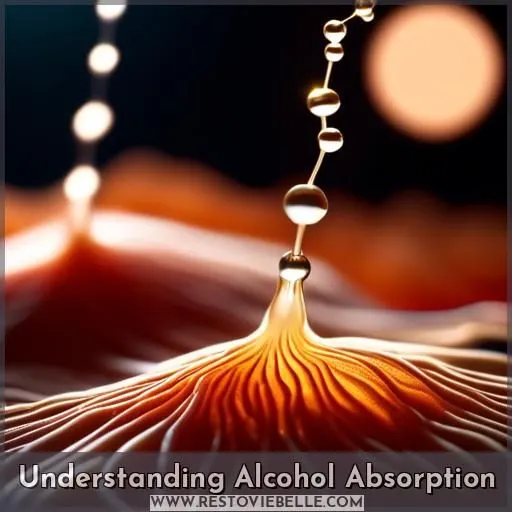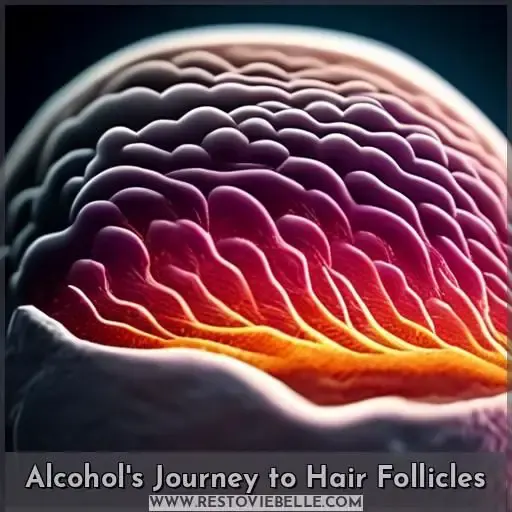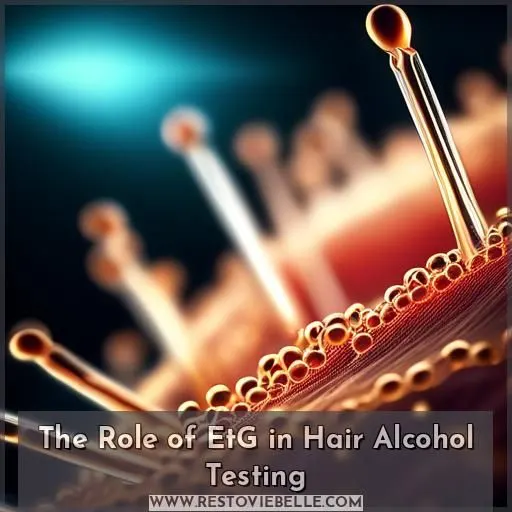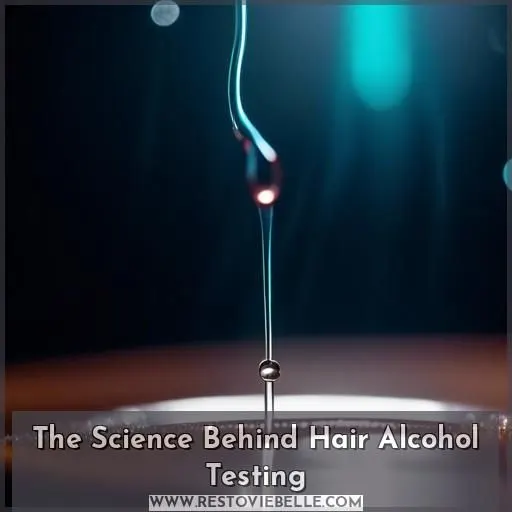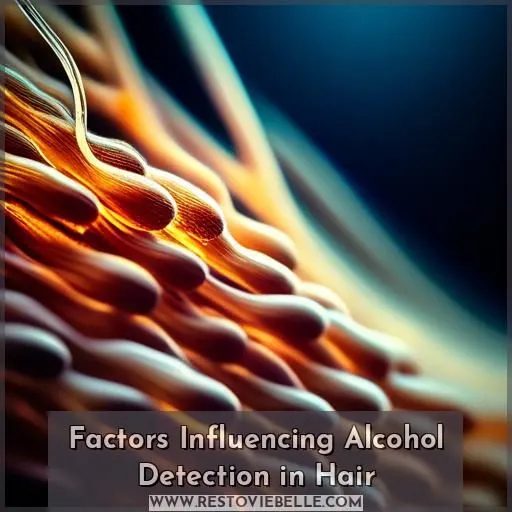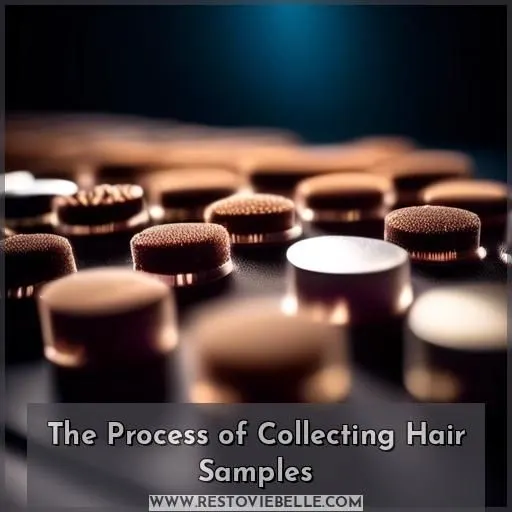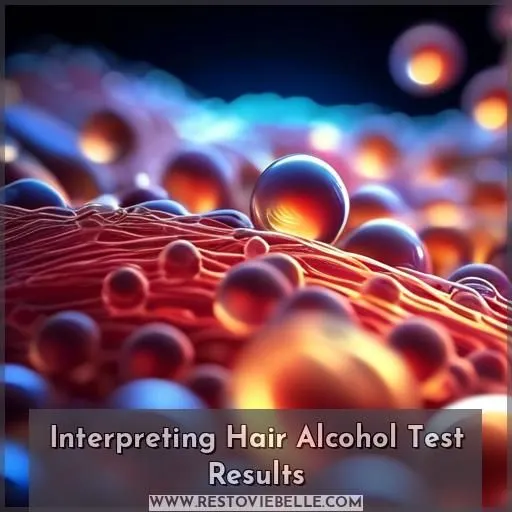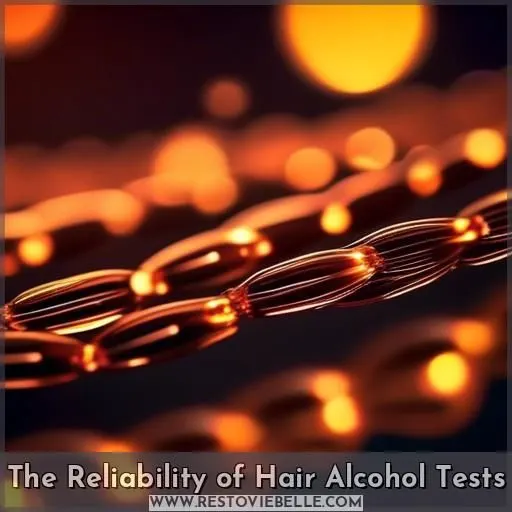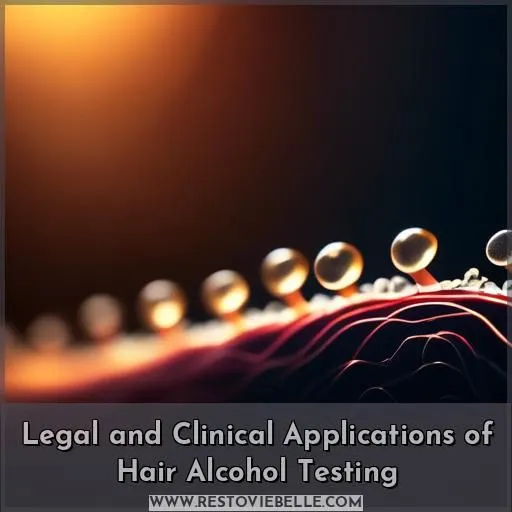This site is supported by our readers. We may earn a commission, at no cost to you, if you purchase through links.
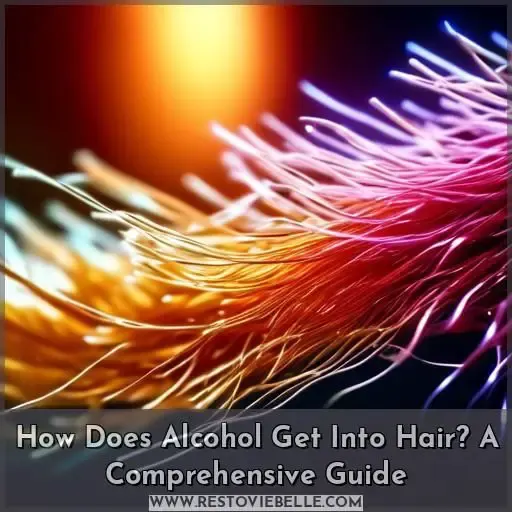
As alcohol circulates through your bloodstream, it diffuses into hair follicles, leaving detectable traces known as EtG.
Hair alcohol testing harnesses this phenomenon, providing insights into your consumption patterns over an extended period.
Embark on this revelatory journey, empowering you with a profound understanding of the mechanics behind this intricate technique.
Table Of Contents
- Key Takeaways
- How Does Alcohol Get Into Hair ?
- Understanding Alcohol Absorption
- Alcohol’s Journey to Hair Follicles
- The Role of EtG in Hair Alcohol Testing
- The Science Behind Hair Alcohol Testing
- Factors Influencing Alcohol Detection in Hair
- The Process of Collecting Hair Samples
- Interpreting Hair Alcohol Test Results
- Comparing Hair Tests With Blood and Urine Tests
- The Reliability of Hair Alcohol Tests
- Legal and Clinical Applications of Hair Alcohol Testing
- Frequently Asked Questions (FAQs)
- Conclusion
Key Takeaways
- Alcohol enters hair through two main pathways: the bloodstream and sweat and diffusion.
- Hair alcohol testing harnesses this phenomenon, providing insights into an individual’s alcohol consumption patterns over an extended period.
- Hair is a reliable indicator of alcohol consumption, as alcohol is trapped in the hair shaft as it grows.
- Hair alcohol tests can detect alcohol use for 1 to 6 months, with detection periods depending on the length of hair available.
How Does Alcohol Get Into Hair ?
Alcohol gets into hair through the process of diffusion and sweat. When alcohol is consumed, alcohol biomarkers such as ethyl glucuronide (EtG) and fatty acid ethyl esters (FAEE) are absorbed into the hair matrix, which is delivered by sebum and sweat.
The apocrine (sweat) glands and sebaceous (sebum) glands open directly into the hair follicle and drain their contents into the hair. This means that the entire length of the hair is contaminated with alcohol, making it difficult to segment the hair for testing in sections.
Understanding Alcohol Absorption
Understanding Alcohol Absorption:
Alcohol is a toxin that enters the body through consumption, typically via the mouth. Once ingested, it’s absorbed directly by the tongue and mucosal lining of the mouth, with a small portion absorbed into the bloodstream through the tissue lining of the stomach and small intestine.
The majority of alcohol absorption occurs in the small intestine, where it’s carried to all organs of the body, including the brain, within minutes.
Alcohol is metabolized by several enzymes, including alcohol dehydrogenase (ADH), aldehyde dehydrogenase (ALDH), cytochrome P450 2E1 (CYP2E1), and catalase. These enzymes help break apart the alcohol molecule, making it possible to eliminate it from the body.
The most common pathway involves ADH, which transforms ethanol into acetaldehyde, and ALDH, which further metabolizes acetaldehyde into acetate, which is then broken down into water and carbon dioxide for easy elimination.
The rate of alcohol metabolism remains constant during continued drinking, but when consumption increases, the number of ADH molecules in the liver becomes saturated, leading to alcohol accumulation in the bloodstream and an increased blood alcohol concentration (BAC).
This can result in intoxication, as alcohol affects the brain and other organs of the body.
Alcohol metabolism is influenced by genetic factors, such as variations in the enzymes that break down alcohol, and environmental factors, such as the amount of alcohol an individual consumes and their overall nutrition.
Differences in alcohol metabolism may put some people at greater risk for alcohol problems, while others may be at least somewhat protected from its harmful effects.
Alcohol’s Journey to Hair Follicles
Alcohol enters your hair follicles through two main pathways: the bloodstream and sweat and diffusion. Once in the follicles, alcohol is trapped in the hair shaft as it grows, providing a record of your alcohol consumption.
Through Bloodstream
Alcohol enters hair through the bloodstream, which is the body’s primary route for absorbing and distributing alcohol.
Alcohol metabolism occurs in the liver, but it takes time for the liver to process alcohol. As a result, alcohol can remain in the bloodstream for several hours, allowing it to be absorbed into hair follicles.
Hair growth rate, external contamination, sample collection methods, genetic factors, and alcohol consumption all play a role in the detection of alcohol in hair.
Blood alcohol tests and blood tests are commonly used to measure alcohol levels in the blood.
However, hair treatments can interfere with hair alcohol testing results.
Via Sweat and Diffusion
Alcohol biomarkers are absorbed into the hair via sweat and diffusion, and are present along the entire length of the hair.
This means that a hair strand test for alcohol can only provide a three- or six-month overview of alcohol use, depending on the length of hair sampled.
For example, a 3cm hair sample represents approximately 3 months of hair growth, while a 6cm sample represents 6 months of growth.
The process of alcohol entering the hair follicle is complex, as it’s influenced by factors such as hair porosity, follicular structure, sweat rates, and genetic factors.
Hair types, such as head hair, arm hair, chest hair, and pubic hair, can also affect the detection of alcohol in hair samples.
Fingernail tests aren’t commonly used for alcohol detection, as alcohol biomarkers aren’t present in nail samples.
The Role of EtG in Hair Alcohol Testing
After alcohol waltzes through your bloodstream, it leaves a trace in your hair, much like footprints in the sand.
Enter EtG, the detective in the world of hair alcohol testing. This savvy marker doesn’t miss a beat, tracking down alcohol’s every move.
However, here’s the kicker: while EtG is sharp, it’s not infallible. Its detection limits can sometimes throw us for a loop, leading to those pesky false positives that have us scratching our heads.
EtG’s distribution and metabolism in our body play a crucial role in how it shows up in our hair. For those battling alcohol misuse or on the path to recovery, understanding EtG hair levels can be a game-changer, offering insights into habits and progress.
So, let’s raise a glass to EtG – the unsung hero of hair alcohol testing, guiding us through the fog of alcohol addiction with a beacon of hope.
The Science Behind Hair Alcohol Testing
Dive into the intricacies of hair alcohol testing, where science meets the strands of your hair. This method, which examines EtG and FAEE markers, offers a window into your alcohol consumption over a specific period.
The alcohol you consume is absorbed into your bloodstream and spreads throughout your tissues, eventually reaching your hair follicles. It’s absorbed through sweat and diffusion, contaminating the entire length of your hair.
Hair damage can occur during this process, but it’s not just about the alcohol. Hair care products and treatments can interfere with the test, and hair type and color can also play a role. Sample contamination and detection limitations are factors to consider, as is the hair growth rate.
Hair alcohol tests are advisable for alcohol abuse, but they can also indicate abstinence or social drinking.
In the realm of hair alcohol testing, it’s not merely about detecting alcohol. It’s about understanding EtG metabolism and the complexities of hair growth. It’s about seeking more than just a test result – it’s about unlocking the secrets of your alcohol consumption.
It’s designed to enhance your understanding of your alcohol use behaviors, helping you navigate the ever-evolving world of alcohol treatment and recovery.
Factors Influencing Alcohol Detection in Hair
Hair care products like shampoos and hair dyes can impact alcohol detection. Different hair types and colors may also affect how much alcohol is absorbed and retained in the hair.
Hair Care Products
Hair care products can significantly impact the results of hair alcohol tests. The use of shampoo residue, bleach effects, color treatments, relaxer influence, and hair dye impact can all affect the concentration of alcohol markers in hair.
For example, bleaching the hair can reduce the level of ethyl glucuronide (EtG) and fatty acid ethyl esters (FAEE), including ethyl palmitate (EtPa), due to the loss of melanin granules and the exposure of the cortex to environmental contamination.
When testing hair for alcohol, it’s essential to consider the potential effects of hair care products. The Society of Hair Testing (SoHT) advises that either EtG or EtPa can be used independently in the assessment of chronic excessive alcohol consumption, but it’s more accurate to use them in combination.
If products containing ethanol (ethyl alcohol) have been used, the EtPa result may be elevated above the cut-off level, while the EtG level wouldn’t be affected.
To obtain the most accurate interpretation of hair alcohol test results, it’s advisable to use both EtG and EtPa markers in combination, as EtPa can be artificially elevated by products containing ethanol.
Donors are advised to refrain from using any treatments or products on their hair in the months prior to hair drug testing or hair alcohol testing to minimize the impact of hair care products on the results.
Hair Type and Color
Hair porosity and natural oils play a crucial role in how alcohol is absorbed into hair. Understanding these factors can help you navigate the complexities of hair alcohol testing.
- Hair Porosity: The ability of hair to absorb and retain moisture affects how alcohol is absorbed. Highly porous hair may absorb alcohol more quickly, while less porous hair may take longer.
- Natural Oils: The presence of natural oils on the hair strands can influence the detection of alcohol. Oily hair may lead to lower alcohol concentrations, while drier hair may result in higher concentrations.
- Color: Hair color doesn’t directly affect alcohol detection, but it may influence how hair is treated and cared for, which can indirectly impact the test results.
- Hair Type: Different hair types (such as head, arm, chest, and pubic hair) may have varying levels of porosity and natural oils, which can influence the accuracy of the test.
By understanding these factors, you can tailor your approach to hair alcohol testing and ensure more accurate results.
The Process of Collecting Hair Samples
Ready to dive into the art of hair sample collection for alcohol testing? Think of it as a covert operation where precision meets stealth.
First up, you’re on a mission to gather about 200 strands of hair, ensuring you don’t raise any alarms (or bald spots!).
This isn’t just any heist; it’s about preserving the integrity of your precious cargo.
Now, for the secret sauce: sample storage. Keep it in a cool, dark place, away from the villainous clutches of sunlight and moisture.
Quality control is your best ally in this quest, ensuring every strand tells the true story.
Interpreting Hair Alcohol Test Results
Interpreting your hair alcohol test results can indicate if you’ve been abusing alcohol or abstaining. High levels of EtG suggest habitual drinking or an alcohol use disorder, while low levels may indicate social drinking or abstinence.
Indicators of Alcohol Abuse
When interpreting hair alcohol test results, it’s crucial to understand the indicators of alcohol abuse.
High concentrations of EtG markers can suggest chronic consumption, frequent drinking, daily intake, or heavy use.
Binge drinking may also be indicated by elevated EtG levels.
These results can provide valuable insights into an individual’s alcohol use patterns, helping to identify potential issues and guide interventions.
Signs of Abstinence
Understanding the Signs of Abstinence in Hair Alcohol Testing
Hair alcohol testing is a valuable tool in determining alcohol consumption patterns over a specific period. When interpreting the results of these tests, it’s essential to consider the signs of abstinence.
Contamination Risk: Hair alcohol tests can detect alcohol consumption for up to 3 or 6 months, depending on the length of the hair sample. However, it’s crucial to note that hair treatments or chemical processes can interfere with the accuracy of the test. As a result, it’s advisable to combine hair alcohol testing with another method for more accurate results.
Secondary Method: Hair alcohol tests should be used in conjunction with other methods, such as blood or urine tests, to provide a more comprehensive understanding of an individual’s alcohol consumption. This approach can help to reduce the risk of false positives or false negatives.
Interpretation Accuracy: The interpretation of hair alcohol test results should be conducted by a qualified professional. Low EtG readings can indicate recreational or social drinking, while high EtG readings may suggest habitual drinking or alcohol use disorder. The concentration of EtG reflects the frequency and quantity of alcohol intake, which can help to determine abstinence or excessive alcohol consumption.
Sample Size: Hair alcohol tests require a sufficient hair sample, typically 200 strands, with a 3cm length for a 3-month period and a 6cm length for a 6-month period. The hair sample should be collected from the crown region of the scalp, following standard methodology.
By considering these factors, you can better understand the signs of abstinence in hair alcohol testing and make more informed decisions based on the results.
Comparing Hair Tests With Blood and Urine Tests
When it comes to determining alcohol consumption, hair tests are a valuable tool that can provide a longer window into a person’s alcohol use behaviors compared to blood and urine tests. Hair alcohol tests are designed to detect ethyl glucuronide (EtG) markers, which are present when a person has consumed alcohol or has had increased blood alcohol levels.
One of the key advantages of hair alcohol tests is their ability to detect alcohol use over a longer period. While blood and urine tests have detection windows of a few days or hours, hair tests can indicate alcohol consumption up to 1 to 6 months after the fact.
This extended detection window can be particularly useful in situations where it’s important to understand a person’s alcohol consumption patterns over a more extended period, such as in cases of suspected alcohol misuse or in legal proceedings.
Hair alcohol tests are considered reliable, but they aren’t infallible. False positives and false negatives can occur, and cosmetic hair treatments like bleaching and perming can interfere with results.
To ensure the most accurate test results, it’s advisable to combine hair tests with blood or urine tests, as each method has its own advantages and limitations.
In terms of sample requirements, hair alcohol tests typically require a small sample of hair, usually taken from the head, but other body hair can also be used. The sample size and length depend on the detection window desired. For example, a 3-month detection window requires a 3cm hair sample, while a 6-month window requires a 6cm sample.
When interpreting hair alcohol test results, it’s important to consider the concentration of EtG, as this can indicate the frequency and quantity of alcohol intake. Low EtG readings may suggest recreational or social drinking, while high EtG readings could indicate habitual drinking or alcohol use disorder.
In conclusion, hair alcohol tests provide a valuable tool for understanding a person’s alcohol consumption patterns over a more extended period compared to blood and urine tests. While they aren’t infallible, they can be used in conjunction with other testing methods to provide a more comprehensive understanding of alcohol use behaviors.
The Reliability of Hair Alcohol Tests
Hair alcohol tests are considered reliable but not infallible. They can detect ethyl glucuronide (EtG) markers in hair, which are direct markers of alcohol consumption.
However, there are limitations to their reliability. False positives and false negatives can occur due to factors such as cosmetic hair treatments, hair care products, and individual metabolism.
To mitigate these limitations, it’s advisable to combine hair alcohol tests with other testing methods, such as blood or urine tests. The Society of Hair Testing provides guidelines for sample collection and handling to ensure accurate results.
Hair alcohol tests can detect alcohol use for 1 to 6 months, with detection periods depending on the length of the hair sample. Interpretation of results should be done by a qualified professional, considering factors such as EtG concentration and the individual’s alcohol consumption patterns.
Legal and Clinical Applications of Hair Alcohol Testing
Hair alcohol testing has significant legal and clinical applications.
It is used in legal proceedings to prove abstinence from alcohol, and laboratory reports are court-admissible.
It can detect alcohol consumption for up to 6 months, depending on the length of hair available.
In the realm of clinical applications, hair alcohol testing is used to monitor alcohol consumption in rehabilitation programs, revealing important details about a patient’s recovery and adherence to sobriety plans.
It can also detect early relapse, enabling prompt intervention.
Hair alcohol testing is also used by insurance companies to assess a person’s risk profile and determine insurance plan pricing.
In aviation and transportation sectors, hair alcohol testing is employed to identify and stop employee drinking, which can significantly impact public safety.
It’s crucial for employers to have a transparent and fair drug-hair testing policy in place and to communicate it to employees.
Frequently Asked Questions (FAQs)
How does alcohol get into hair?
You’re right to wonder – alcohol enters hair via sweat and diffusion from blood into hair follicles. Tiny amounts get trapped as your hair grows, creating a record of past alcohol exposure.
What is the detection window for alcohol in hair?
Alcohol hair tests can detect drinking over the past 3-6 months. The window extends back several weeks from when you last consumed alcohol.
How is EtG formed in hair?
insert anachronism EtG forms when alcohol metabolizes into ethyl glucuronide, which travels via your bloodstream to sweat glands, diffusing into hair’s core.
What factors influence the accuracy of hair alcohol tests?
Hair treatments like dyes, bleaches, and perms can impact test accuracy. Your hair’s health, growth rate, and alcohol metabolism also play a role. Combining hair tests with other methods like blood or urine enhances reliability.
How does hair alcohol testing compare to blood and urine tests?
Hair tests give a larger window into past alcohol use compared to blood or urine. You get insight into drinking patterns over months rather than days. But combining methods provides the clearest picture.
Conclusion
What revelations await as you unveil how alcohol gets into hair? This scientific method illuminates your consumption patterns, aiding clinical assessments and legal proceedings. With an intimate grasp of alcohol’s pathway through bloodstreams and follicles, you’ll comprehend hair testing’s precision in detecting EtG biomarkers—telltale signs of indulgence or abstinence over months.

